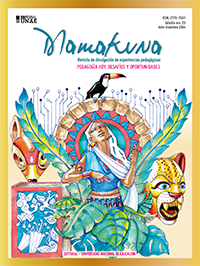Audioactivities: a technological educational resource to promote inclusive processes for students with visual disabilities
DOI:
https://doi.org/10.70141/mamakuna.23.976Keywords:
audioactivities, visual impairment, inclusion, curricular adaptationAbstract
The purpose of this research is to share the experiences of teachers after the implementation of the technological resource Audioactivities. The resource arises from the particular needs of students with visual impairment (VI), based on a methodological barrier, processes of educational monotony and teachers’ lack of knowledge about the same disability and ways of adapting educational resources. For the application of this research, a phenomenological design was used to obtain the feelings, emotions, reactions and experiences of the participants during the implementation of the resource. Subsequently, all the information gathered was contrasted with data collection tools such as interviews, digital databases, teachers’ audios and field diaries. Finally, the findings are presented in relation to the inclusive processes offered by the audio activities for students with DV.
Downloads
References
Alexander, P. y Singh, A. (2022). Audiobooks, print, and comprehension: what we know and what we need to know. Educ Psychol Rev, 34(1), 677-715. https://doi.org/10.1007/s10648-021-09653-2
Arias, A., Llamazares, J. y Melcon, M. (2017). Theoretical review of visual impairment, study on the importance of creativity in education. Sophia, 13(2), 106-119. https://doi.org/10.18634/sophiaj.13v.2i.666
Armayones, M., Cardona, G. y Lupón, M. (2019). Assessing the quality of Spanish websites providing information on visual impairment. SemFYC, (51), 255-256. https://doi.org/10.1016/j.aprim.2018.09.013
Barrantes, R. (2014). Investigación: un camino al conocimiento. Un enfoque cualitativo, cuantitativo y mixto. EUNED.
Carvalho, A., De Almeida, P., Guimarães, F. y Mariano, M. (2022). Health education technologies for people with visual impairment: integrative review. Texto y Contexto-Enfermagem, 31, 1-15. https://n9.cl/khevb
De la Fuente, D., Hernández, M. y Pra, I. (2018). Vídeo educativo y rendimiento académico en la enseñanza superior a distancia. RIED-Revista Iberoamericana de Educación a Distancia, 21(1), 323-341. https://doi.org/10.5944/ried.21.1.18326
Esparza, A., Margain, L., Álvarez, F. y Benítez, E. (2018). Desarrollo y evaluación de un sistema interactivo para personas con discapacidad visual. TecnoLógicas, 21(41), 149-157. https://www.redalyc.org/journal/3442/344255038009/344255038009.pdf
Hernández-Sampieri, R., Baptista, M. y Fernández, C. (2018). Metodología de la investigación. McGraw-Hill Interamericana.
Hermida, G. (2017). Herramientas de apoyo para la discapacidad visual. ONCE.
Mateos-Fernández, L., Pedrosa, I. y Solís, P. (2019). Methodologies for the inclusive education of students with severe visual impairment or blindness. Cultura y Educación, 31(3), 576-608. https://doi.org/10.1080/11356405.2016.1170336
Méndez, J., Prats, L., Sanza, A. y Yagüe, F. (2016). Perceived control, coping and psychological adjustment to visual disability. ScienceDirect, 2(2), 55-61. https://doi.org/10.1016/j.anyes.2016.09.002
Méndez, K. y Vásquez, C. (2021). Guía metodológica dirigida al docente, en la diversificación de medios y materiales para potenciar la inclusión educativa de estudiantes con discapacidad visual [Tesis de grado no publicada]. Universidad Nacional de Educación.
Núñez, Á. y López, M. (2020). Identificación de necesidades de apoyo para el aprendizaje y la participación de estudiantes universitarios con discapacidad visual: un estudio biográfico narrativo. Calidad en la educación, (53), 42-76. https://www.calidadenlaeducacion.cl/index.php/rce/article/view/518
Organización Mundial de la Salud [OMS]. (26 de febrero de 2021). Ceguera y discapacidad visual. Organización Mundial de la Salud. https://n9.cl/rbxs
Ponce, J. y Salazar, G. (2021). Tiflotecnología en la accesibilidad educativa universitaria como recurso para estudiantes con discapacidad visual. Ciencia Latina. Revista multidiciplinaria, 5(1), 42-65. https://doi.org/10.37811/cl_rcm.v5i1.208
Sánchez-Serrano, J. (2022). Eficacia de la formación docente en diseño universal para el aprendizaje: Una revisión sistemática de literatura (2000-2020). Joned, 3(1), 17-33. https://doi.org/10.1344/joned.v3i1.39657
Sevilla, D., Martín, M. y Jenaro, C. (2018). Actitud del docente hacia la educación inclusiva y hacia los estudiantes con necesidades educativas especiales. Innovación Educativa, 18(78), 115-141. https://n9.cl/apjqb
Zamora López, P. y Marín Perabá, C. (2021). Tiflotecnologías para el alumnado con discapacidad visual. Academo, 8(1), 109-118. https://revistacientifica.uamericana.edu.py/index.php/academo/article/view/427
Published
How to Cite
Issue
Section
License
Copyright (c) 2024 Mamakuna

This work is licensed under a Creative Commons Attribution-NonCommercial-ShareAlike 4.0 International License.





